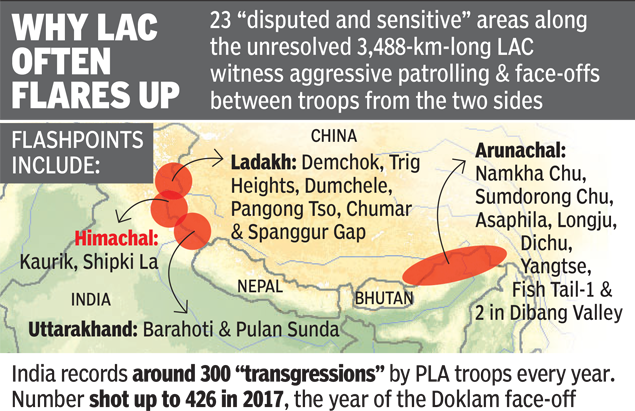Why in news?
With nearly four incidents along the Line of Actual Control (LAC) in recent weeks, India-China border is witnessing the highest tensions since the Doklam stand-off in 2017. Click here to know more
How have things been since the Doklam issue?
- In the 3 years since the Doklam stand-off, both sides have done remarkably well to keep the peace.
- Prime Minister Modi and President Xi both agreed differences should not be allowed to escalate into disputes.
- Also, a clear message was sent to the two militaries to abide by the detailed protocols in place, such as those agreed to in 2005 and 2013.
- These regulate the activities of troops in the contested zones that lie in between both sides’ overlapping claim lines of the undefined LAC.

What is the current dispute?
- China's Foreign Ministry accused the Indian Army of “attempting to unilaterally change the status” of the LAC.
- The stand-off in Ladakh appears to have been triggered by China moving in troops to obstruct road construction activity by India.
- In 2019, India completed the Darbuk-Shyok-Daulet Beg Oldi (DBO) road which connects Leh to the Karakoram Pass.
- India also maintains a key landing strip at DBO at 16,000 feet.
What is the larger concern?
- The broader context for the tensions is the changing dynamic along the LAC.
- India has been upgrading its roads.
- It is well within India's right to carry out construction work.
- China already enjoys an advantage in both terrain and infrastructure.
- But China now seems to be telling India it has no right to carry out the kind of activity that Beijing has already done.
What is the way forward?
- Delhi needs to remind Beijing that a fundamental principle in all previous agreements is recognising the right to mutual and equal security of the two sides.
- The immediate priority now is for both sides to use existing channels and step back.
- Flag meetings between brigade commanders have so far been unable to break the stalemate.
- The incidents have underlined how the new LAC situation is placing existing mechanisms under renewed stress.
- So, India and China should grasp the current situation as an opportunity to revive the stalled process of clarifying the LAC.
- China has resisted this as a distraction to the boundary negotiations.
- But rather than agree on a line, both can instead simply seek to better understand the claims of the other.
- They can reach a common understanding to regulate activity in these areas.
- Clarifying the LAC may even provide a fresh impetus to the stalled boundary talks between the Special Representatives.
- A final settlement will ultimately have to use the LAC as a basis, with only minor adjustments.
- In the midst of an unprecedented global pandemic, it is time both the countries push for a settlement.
Source: The Hindu
